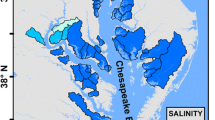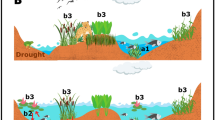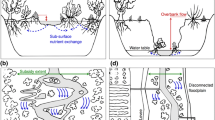Abstract
A conceptual ecological model of the effects of the major anthropogenic stressors on the Everglades ridge and slough system was developed as a planning tool for designing and assessing the Everglades restoration program. The pre-drainage Everglades ridge and slough system was an expansive, hydrologically integrated, long-hydroperiod, low-nutrient freshwater marsh, characterized by low-velocity sheet-flow, long-term water storage capacity, moderate-to-deep organic soils, and alternating sawgrass ridges and more open-water slough communities. Depth, distribution, and duration of surface flooding in this environment largely determined vegetation patterns, as well as distribution, abundance, seasonal movements, and reproductive dynamics of all aquatic and many terrestrial animals. Drivers on the system are urban and agricultural expansion, industrial and agricultural practices, water management practices, and human influences on species composition. These drivers lead to five major ecosystem stressors: reduced spatial extent, degraded water quality, reduced water storage capacity, compartmentalization, and exotic species. Attributes that are affected by these stressors and can be used as indicators of restoration success include periphyton, marsh plant communities, tree islands, alligators, wading birds, and marsh fishes, invertebrates, and herpetofauna.
Similar content being viewed by others
Literature Cited
Bennetts, R. E., M. C. Collopy, and J. A. Rodgers, Jr. 1994. The snail kite in the Florida Everglades: a food specialist. p. 507–532. In S. M. Davis and J. C. Ogden (eds.) Everglades, the Ecosystem and its Restoration. St. Lucie Press, Delray Beach, FL, USA.
Browder, J. A. 1976. Water, wetlands, and wood storks in southwest Florida. Ph.D. Dissertation. University of Florida, Gainesville, FL, USA.
Browder, J. A., P. J. Gleason, and D. R. Swift. 1994. Periphyton in the Everglades: spatial variation, environmental correlates, and ecological implications. p. 379–416. In S. M. Davis and J. C. Ogden (eds.) Everglades, the Ecosystem and its Restoration. St. Lucie Press, Delray Beach, FL, USA.
Browder, J. and J. C. Ogden. 1999. The natural South Florida system II: pre-drainage ecology. Urban Ecosystems 3: 125–158.
Craighead, F. C., Sr. 1968. The role of the alligator in shaping plant communities and maintaining wildlife in the southern Everglades. Florida Naturalist 41: 2–7, 69–74, 94.
Craighead, F. C., Sr. 1971. The Trees of South Florida. Volume 1: The Natural Environments and Their Succession. University of Miami Press, Coral Gables, FL, USA.
Davis, S. M. 1994. Phosphorus inputs and vegetation sensitivity in the Everglades. p. 357–378. In S. M. Davis and J. C. Ogden (eds.) Everglades, the Ecosystem and its Restoration. St. Lucie Press, Delray Beach, FL, USA.
Davis, S., L. Gunderson, R. Hofstetter, D. Swift, and B. Waller. 1987. An assessment of the potential benefits to the vegetation and water resources of Everglades National Park and the southern Everglades ecosystem associated with the General Design Memorandum to Improve Water Deliveries to Everglades National Park. South Florida Research Center, Everglades National Park, Homestead, FL, USA. Statement paper.
Davis, S. M., L. H. Gunderson, W. A. Park, J. Richardson, and J. Mattson. 1994. Landscape dimension, composition, and function in a changing Everglades ecosystem. p. 419–444. In S. M. Davis and J. C. Ogden (eds.) Everglades, the Ecosystem and its Restoration. St. Lucie Press, Delray Beach, FL, USA.
Davis, S. M. and J. C. Ogden. 1994. Towards ecosystem restoration. p. 769–796. In Davis, S. M. and J. C. Ogden (eds.) Everglades, the Ecosystem and its Restoration. St. Lucie Press, Delray Beach, FL, USA.
DeAngelis, D. L. 1994. Synthesis: spatial and temporal characteristics of the environment. p. 307–320. In S. M. Davis and J. C. Ogden (eds.) Everglades, the Ecosystem and its Restoration. St. Lucie Press, Delray Beach, FL, USA.
DeAngelis, D. L. and P. S. White. 1994. Ecosystems as products of spatially and temporally varying driving forces, ecological processes, and landscapes. p. 9–27. In S. M. Davis and J. C. Ogden (eds.) Everglades, the Ecosystem and its Restoration. St. Lucie Press, Delray Beach, FL, USA.
Doren, R. F. 2000. Weeds won’t wait. An assessment of invasive plants in Florida. South Florida Ecosystem Restoration Task Force and Working Group, Miami, FL, USA.
Duever, M. J., J. F. Meeder, L. C. Meeder, and J. M. McCollom. 1994. The climate of South Florida and its role in shaping the Everglades ecosystem. p. 225–248. In S. M. Davis and J. C. Ogden (eds.) Everglades, the Ecosystem and its Restoration. St. Lucie Press, Delray Beach, FL, USA.
Fennema, R. J., C. J. Neidrauer, R. A. Johnson, W. A. Perkins, and T. K. MacVicar. 1994. A computer model to simulate natural South Florida hydrology, p. 249–289. In S. M. Davis and J. C. Ogden (eds.) Everglades, the Ecosystem and its Restoration. St. Lucie Press, Delray Beach, FL, USA.
Frederick, P. C. and J. C. Ogden. 2001. Pulsed breeding of long-legged wading birds and the importance of infrequent severe drought conditions in the Florida Everglades. Wetlands 21: 4.
Gawlik, D. E. (ed.). 1999. South Florida wading bird report, volume 5. South Florida Water Management District, West Palm Beach, FL, USA.
Gawlik, D. E. and D. A. Rocque. 1998. Avian communities in bay-heads, willowheads, and sawgrass marshes of the central Everglades. Wilson Bulletin 110: 45–55.
Gleason, P. J. and W. Spackman, Jr. 1974. Calcareous periphyton and water chemistry in the Everglades. p. 146–181 In P. J. Gleason (ed.) Environments of South Florida: Present and Past. Miami Geological Society, Miami, FL, USA. Memoir 2.
Goodyear, C. 2000. Initial status survey of nonindigenous animals in South Florida. South Florida Ecosystem Restoration Working Group, Miami, FL, USA. May 2000 draft.
Gunderson, L. H. 1994. Vegetation of the Everglades: determinants of community composition. p. 323–340. In S. M. Davis and J. C. Ogden (eds.) Everglades, the Ecosystem and its Restoration. St. Lucie Press, Delray Beach, FL, USA.
Gunderson, L. H. and W. F. Loftus. 1993. The Everglades. p. 199–255. In W. H. Martin, S. G. Boyce, and A. C. Echternacht (eds.) Biotic Communities of the Southern United States. John Wiley and Sons, New York, NY, USA.
Gunderson, L. H. and J. R. Snyder. 1994. Fire patterns in the southern Everglades. p. 291–305. In S. M. Davis and J. C. Ogden (eds.) Everglades, the Ecosystem and its Restoration. St. Lucie Press, Delray Beach, FL, USA.
Hoffman, W., G. T. Bancroft, and R. J. Sawicki. 1989. Wading Bird populations and distributions in the Water Conservation Areas of the Everglades, 1985–1988. South Florida Water Management District, West Palm Beach, FL, USA.
Hoffman, W., G. T. Bancroft, and R. J. Sawicki. 1994. Foraging habitat of wading birds in the water conservation areas of the Everglades. p. 585–614. In S. M. Davis and J. C. Ogden (eds.) Everglades, the Ecosystem and its Restoration. St. Lucie Press, Delray Beach, FL, USA.
Holling, C. S., L. H. Gunderson, and C. J. Walters. 1994. The structure and dynamics of the Everglades system: guidelines for ecosystem restoration. p. 741–756. In S. M. Davis and J. C. Ogden (eds.) Everglades, the Ecosystem and its Restoration. St. Lucie Press, Delray Beach, FL, USA.
Jacobsen, T. and J. A. Kushlan. 1984. Population status of the American alligator (Alligator mississippiensis) in Everglades National Park. South Florida Research Center, Everglades National Park, Homestead, FL, USA.
Kolopinski, M. C. and A. L. Higer. 1969. Some aspects of the effects of the quantity and quality of water on biological communities in the Everglades National Park. United States Geological Survey, Washington, DC, USA. Open File Report 69007.
Kushlan, J. A. 1979. Feeding ecology and prey selection in the white ibis. Condor 81: 376–389.
Kushlan, J. A. 1986. Responses of wading birds to seasonally fluctuating water levels: strategies and their limits. Colonial Waterbirds 9: 155–162.
Kushlan, J. A. 1989. Wetlands and wildlife, the Everglades perspective. p. 773–790. In R. R. Sharitz and J. W. Gibbons (eds.) Freshwater Wetlands and Wildlife, United States Department of Energy, Oak Ridge, TN, USA. Symposium Series No. 61.
Kushlan, J. A. and T. Jacobsen. 1990. Environmental variability and the reproductive success of Everglades alligators. Journal of Herpetolology 24: 176–184.
Light, S. S. and J. W. Dineen. 1994. Water control in the Everglades: a historical perspective. p. 47–84. In S. M. Davis and J. C. Ogden (eds.) Everglades, the Ecosystem and its Restoration. St. Lucie Press, Delray Beach, FL, USA.
Loftus, W. F., J. D. Chapman, and R. Conrow. 1990. Hydrological effects on Everglades marsh food webs, with relation to marsh restoration efforts. p. 1–22. In G. Larson and M. Soukup (eds.) 1986 Conference on Science in the National Parks Proceedings, Volume 6: Fisheries and Coastal Wetlands Research. George Wright Society, Hancock, MI, USA.
Loftus, W. F. and A. Eklund. 1994. Long-term dynamics of an Everglades small-fish assemblage. p. 461–483. In S. M. Davis and J. C. Ogden (eds.) Everglades, the Ecosystem and its Restoration. St. Lucie Press, Delray Beach, FL, USA.
Loftus, W. F. and J. A. Kushlan. 1987. Freshwater fishes of southern Florida. Bulletin Florida State Museum 31: 147–344.
Mazzotti, F. J. and L. A. Brandt. 1994. Ecology of the American alligator in a seasonally fluctuating environment. p. 485–505. In S. M. Davis and J. C. Ogden (eds.) Everglades, the Ecosystem and its Restoration. St. Lucie Press, Delray Beach, FL, USA.
Ogden, J. C. 1994. A comparison of wading bird nesting colony dynamics (1931–1946 and 1974–1989) as an indication of ecosystem conditions in the southern Everglades. p. 533–570. In S. M. Davis and J. C. Ogden (eds.) Everglades, the Ecosystem and its Restoration. St. Lucie Press, Delray Beach, FL, USA.
Ogden, J. C., S. M. Davis, and L. A. Brandt. 2003. Science for a regional ecosystem monitoring and assessment program: the Florida Everglades example. p. 135–160. In D. E. Busch and J. C. Trexler (eds.) Monitoring Systems: Interdisciplinary Approaches for Evaluating Ecoregional Initiatives. Island Press, Washington, DC, USA.
Ogden, J. C., J. Browder, J. H. Gentile, L. H. Gunderson, R. Fennema, and J. Wang. 1999. Environmental management scenarios: ecological implications. Urban Ecosystems 3: 159–184.
Ogden, J. C., S. M. Davis, K. J. Jacobs, T. Barnes, and H. E. Fling. 2005. The use of conceptual ecological models to guide ecosystem restoration in south Florida. Wetlands 25: (in press).
Olmsted, I. and T. V. Armentano. 1997. Vegetation of Shark Slough, Everglades National Park. South Florida Natural Resources Center, Everglades National Park. Homestead, FL, USA. Report 97-001.
Patterson, K. and R. Finck. 1999. Tree islands of WCA3. Aerial photointerpretation and trend analysis project summary report. South Florida Water Management District, West Palm Beach, FL, USA.
Science Coordination Team. 2003. The role of flow in the Everglades ridge and slough landscape. Science Coordination Team, South Florida Ecosystem Restoration Task Force, Miami, FL, USA.
Science Subgroup. 1993. Federal objectives for the South Florida restoration. South Florida Management and Coordination Working Group, South Florida Ecosystem Restoration Task Force, Miami, FL, USA.
Science Subgroup. 1994. South Florida ecosystem restoration: scientific information needs. Management and Coordination Working Group, Interagency Task Force on the South Florida Ecosystem, Miami, FL, USA.
SFWMD. 1992. Surface water improvement and management plan for the Everglades: supporting information needs document. South Florida Water Management District, West Palm Beach, FL, USA.
Sklar, F., L. Brandt, D. DeAngelis, C. Fitz, D. Gawlik, S. Krupa, C. Madden, F. Mazzotti, C. McVoy, S. Miao, D. Rudnick, K. Rutchney, K. Tarboton, L. Vilchek, and Y. Wu. 2000. Hydrological needs—effects of hydrology on the Everglades. p. 2-1 to 2-62. In Everglades Consolidated Report. South Florida Water Management District, West Palm Beach, FL, USA.
Spalding, M. G. and D. J. Forrester. 1991. Effects of parasitism and disease on the nesting success of colonial wading birds (ciconiiformes) in southern Florida. Nongame Wildlife Program Report NG88-008, Florida Game and Fresh Water Fish Commission, Tallahassee, FL, USA.
Thayer, D., A. Ferriter, M. Bodie, K. Langeland, K. Serbesoff, D. Jones, and B. Doren. 2000. Exotic plants in the Everglades. p. 14–1 to 14-48. In Everglades Consolidated Report. South Florida Water Management District, West Palm Beach, FL, USA.
Trexler, J. and F. Jordan. 1999. Fish and aquatic macroinvertebrate population studies in the Water Conservation Areas. Final report for South Florida Water Management District contract no. C-E636, West Palm Beach, FL, USA.
Tropical BioIndustries, Inc. 1990. Hydroperiod conditions of key environmental indicators of Everglades National Park and adjacent east Everglades area as guide to selection of an optimum water plan for Everglades National Park, Florida. Final report for contract with United States Army Corps of Engineers, Jacksonville District, Jacksonville, FL, USA.
USACE and SFWMD. 1999. Central and Southern Florida Project comprehensive review study final integrated feasibility report and programmatic environmental impact statement. U.S. Army Corps of Engineers, Jacksonville district, Jacksonville, FL, USA and South Florida Water Management District, West Palm Beach, FL, USA.
van der Valk, A., F. Sklar, D. Mason, D. Gawlik, P. Wetzel, S. Newman, C. McVoy, Y. Wu, S. Miao, S. Krupa, and M. Korvela. 1998. Proposed plan of work for tree island research. Everglades Systems Research Division, South Florida Water Management District, West Palm Beach, FL, USA.
Walters, C. J. and L. H. Gunderson. 1994. A screening of water policy alternatives for ecological restoration in the Everglades. p. 757–767. In S. M. Davis and J. C. Ogden (eds.) Everglades, the Ecosystem and its Restoration. St. Lucie Press, Delray Beach, FL, USA.
Author information
Authors and Affiliations
Corresponding author
Rights and permissions
About this article
Cite this article
Ogden, J.C. Everglades ridge and slough conceptual ecological model. Wetlands 25, 810–820 (2005). https://doi.org/10.1672/0277-5212(2005)025[0810:ERASCE]2.0.CO;2
Received:
Revised:
Accepted:
Issue Date:
DOI: https://doi.org/10.1672/0277-5212(2005)025[0810:ERASCE]2.0.CO;2




